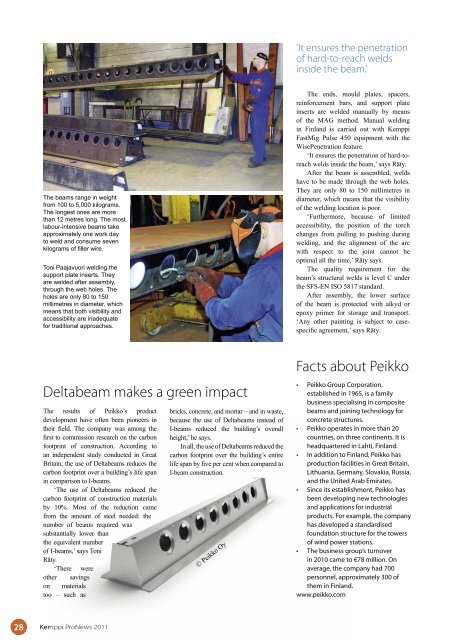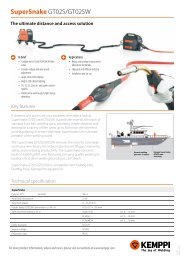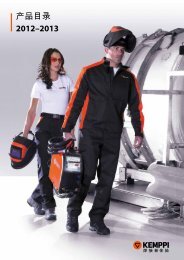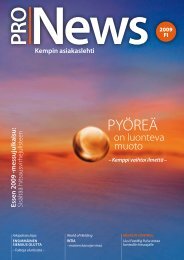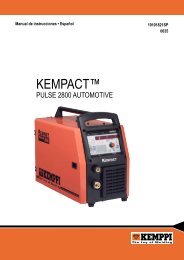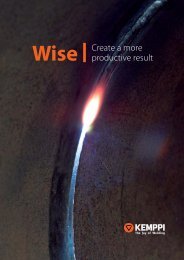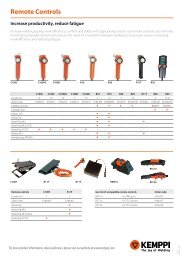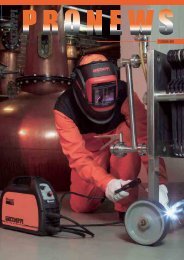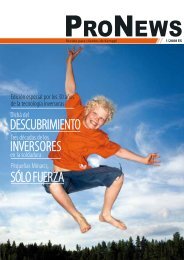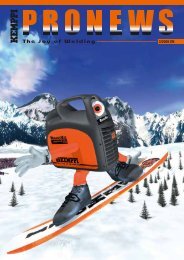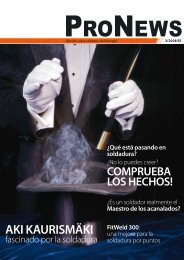Download - Kemppi Connections
Download - Kemppi Connections
Download - Kemppi Connections
Create successful ePaper yourself
Turn your PDF publications into a flip-book with our unique Google optimized e-Paper software.
‘It ensures the penetration<br />
of hard-to-reach welds<br />
inside the beam.’<br />
The beams range in weight<br />
from 100 to 5,000 kilograms.<br />
The longest ones are more<br />
than 12 metres long. The most<br />
labour-intensive beams take<br />
approximately one work day<br />
to weld and consume seven<br />
kilograms of filler wire.<br />
Toni Paajavuori welding the<br />
support plate inserts. They<br />
are welded after assembly,<br />
through the web holes. The<br />
holes are only 80 to 150<br />
millimetres in diameter, which<br />
means that both visibility and<br />
accessibility are inadequate<br />
for traditional approaches.<br />
The ends, mould plates, spacers,<br />
reinforcement bars, and support plate<br />
inserts are welded manually by means<br />
of the MAG method. Manual welding<br />
in Finland is carried out with <strong>Kemppi</strong><br />
FastMig Pulse 450 equipment with the<br />
WisePenetration feature.<br />
‘It ensures the penetration of hard-toreach<br />
welds inside the beam,’ says Räty.<br />
After the beam is assembled, welds<br />
have to be made through the web holes.<br />
They are only 80 to 150 millimetres in<br />
diameter, which means that the visibility<br />
of the welding location is poor.<br />
‘Furthermore, because of limited<br />
accessibility, the position of the torch<br />
changes from pulling to pushing during<br />
welding, and the alignment of the arc<br />
with respect to the joint cannot be<br />
optimal all the time,’ Räty says.<br />
The quality requirement for the<br />
beam’s structural welds is level C under<br />
the SFS-EN ISO 5817 standard.<br />
After assembly, the lower surface<br />
of the beam is protected with alkyd or<br />
epoxy primer for storage and transport.<br />
‘Any other painting is subject to casespecific<br />
agreement,’ says Räty.<br />
Deltabeam makes a green impact<br />
The results of Peikko’s product<br />
development have often been pioneers in<br />
their field. The company was among the<br />
first to commission research on the carbon<br />
footprint of construction. According to<br />
an independent study conducted in Great<br />
Britain, the use of Deltabeams reduces the<br />
carbon footprint over a building’s life span<br />
in comparison to I-beams.<br />
‘The use of Deltabeams reduced the<br />
carbon footprint of construction materials<br />
by 10%. Most of the reduction came<br />
from the amount of steel needed: the<br />
number of beams required was<br />
substantially lower than<br />
the equivalent number<br />
of I-beams,’ says Toni<br />
Räty.<br />
‘There were<br />
other savings<br />
on materials<br />
too – such as<br />
bricks, concrete, and mortar – and in waste,<br />
because the use of Deltabeams instead of<br />
I-beams reduced the building’s overall<br />
height,’ he says.<br />
In all, the use of Deltabeams reduced the<br />
carbon footprint over the building’s entire<br />
life span by five per cent when compared to<br />
I-beam construction.<br />
© Peikko Oy<br />
Facts about Peikko<br />
• Peikko Group Corporation,<br />
established in 1965, is a family<br />
business specialising in composite<br />
beams and joining technology for<br />
concrete structures.<br />
• Peikko operates in more than 20<br />
countries, on three continents. It is<br />
headquartered in Lahti, Finland.<br />
• In addition to Finland, Peikko has<br />
production facilities in Great Britain,<br />
Lithuania, Germany, Slovakia, Russia,<br />
and the United Arab Emirates.<br />
• Since its establishment, Peikko has<br />
been developing new technologies<br />
and applications for industrial<br />
products. For example, the company<br />
has developed a standardised<br />
foundation structure for the towers<br />
of wind power stations.<br />
• The business group’s turnover<br />
in 2010 came to €78 million. On<br />
average, the company had 700<br />
personnel, approximately 300 of<br />
them in Finland.<br />
www.peikko.com<br />
28 <strong>Kemppi</strong> ProNews 2011


